I have a problem making a circuit like this working 
I got it from this TI application note. For testing purposes I have set:
\$R4=R2=R3=R1=47 \Omega\$
\$ Rf = 10 k\Omega\$
\$Rg= 26.70\Omega\$
The op amp \$V_S=+5V\$. This should give a gain of 750 having \$V_{SIG}\$ as 0.8E-4V/kg.
I agreed that 80kg would be enough for full scale. The problem is that this setup doesn't show any variations when i load the strain gauge. It just stays at 2.40V which doesn't make much sense since it doesn't reach near \$V_S\$. I am using the TL064. I have tried a lot and think my wiring is correct. Do you have any suggestions?
Update: I came up with the 750 of gain by assuming that:
\$R4=R2 <=> \dfrac{R4}{R2}=1\$
\$Gain=\dfrac{2Rf}{Rg}+1\$
\$(Sig_+)-(Sig_-) = V_{IN} => V_O=V_{IN} \times 1 \times Gain <=>\$
\$Gain = \dfrac{V_O}{V_{IN}} <=> \dfrac{2Rf}{Rg}+1 = \dfrac{V_O}{V_{IN}}.\$
\$V_{IN}/kg = 0.8E-4V/kg\$
I also i assumed that my absolute maximum load would be 80kg. So \$V_{IN(MAX)} = 0.8E-4 \times 80 = 6.4E-3\$ V
So we can determine the needed gain for
\$V_{OUT}=5V. G=\dfrac{V_{OUT}}{V_{IN}}=\dfrac{4.8}{6.4E-3}=750\$
Taking the previous equations: \$ \dfrac{2Rf}{Rg}+1 = 750 <=> 2Rf = 749 Rg <=> Rg = \dfrac{Rf}{374.5}\$
Knowing this and the resistors I had available I chose to set Rg as a function of Rf because i have to arrange the resistors(series or parallels to approximately get the desired gain) I chose:
Edit:
Corrected Equation mistake but still no results
\$Rf=10 k\Omega => Rg = 10E3/374.5 = 26.70 \Omega\$
Considering I don't have this precise value I came up with
\$Rg = 47 || 47 = 23.5\$ which is close to \$26.70 \Omega\$
Hope everything is clear for everybody, otherwise please ask for clarifications Thank you